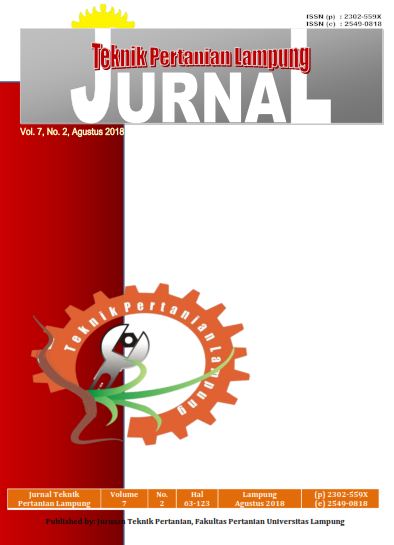EVALUASI NON-DESTRUSTIF KANDUNGAN ASAM LEMAK BEBAS (ALB) TANDAN BUAH SEGAR (TBS) KELAPA SAWIT DENGAN METODE NIR SPEKTROSKOPI
DOI:
https://doi.org/10.23960/jtep-l.v7i2.80-87Abstract
Kadar Asam Lemak Bebas (ALB) yang rendah merupakan salah satu indikator kualitas Crude Palm Oil (CPO) yang baik. Apabila Tandan Buah Segar (TBS) kelapa sawit yang lewat matang ikut diolah menjadi CPO, maka kadar ALB selama produksi dapat meningkat. Proses pemanenan menjadi titik krusial yang sangat mempengaruhi tingkat kematangan buah. Selama ini penentuan kematangan TBS kelapa sawit masih dilakukan secara visual yang bergantung kepada kemampuan dan kondisi pemanen buah sawit. Oleh karena itu, perlu dikembangkan suatu metode secara kuantitatif yang dapat memprediksi kadar ALB secara objektif. Pada penelitian ini, akan dikembangankan metode non-destruktif berbasis NIR spectroscopy yang akan dikaji sebagai metode untuk menentukan tingkat kematangan TBS berdasarkan kandungan ALB. Penelitian ini dibagi menjadi tiga tahapan, yaitu akuisisi data reflektansi spektrum TBS dengan NIR Flex N-500, pengukuran kadar ALB, dan pembangunan model kalibrasi dengan menggunakan kemometrik. Dari hasil pengembangan model didapatkan nilai R2 tanpa preprocessing sebesar 0.236, RPD sebesar 1.27 dan PC sebesar 2. Proprocessing First Derivative Savitzky Golay (DG1) memberikan nilai koefisien determinasi tertinggi yaitu sebesar 0.243, dengan nilai RPD sebesar 1.17 dan PC sebesar 2. Akan tetapi kualitas model kalibrasi yang dibangun tetap belum mampu menunjukkan kehandalan dalam memprediksi kandungan ALB tandan buah segar kelapa sawit.
References
Arendse E, Fawole OA, Magwaza LS and Opara UL. 2018. Non-destructive prediction of internal and external quality attributes of fruit with thick rind: A review. Journal of Food Engineering, vol.21, pp.11–23
Badan Standarisasi Nasional. 1998. SNI 01-3555-1998 : Cara Uji Minyak dan Lemak.
CAMO. 2012. Method Reference the Unscrambler X. Dilihat 2 Maret 2018. <http://www.camo.com/helpdocs/The_Unscrambler_Method_References.pdf >
Cayuela JA and GarcÃa JF. 2017. Sorting olive oil based on alpha-tocopherol and total tocopherol content using near-infra-red spectroscopy (NIRS) analysis. Journal of Food Engineering. vol.202, pp.79–88
Fauzi Y, Widyastuti YE, Satyawibawa I, Hartono R.2007. Kelapa Sawit : Budidaya, Pemanfaatan Hasil dan Limbah, Analisis Usaha dan Pemasaran. Penebar Swadaya, Jakarta
Jha SN, Narsaiah K, Jaiswal P, Bhardwaj R, Gupta M., Kumar R and Sharma R. 2014. Nondestructive prediction of maturity of mango using near infrared spectroscopy. Journal of Food Engineering, vol.124, pp.152–157
Karoui R, Mouazen AM, Dufour E, Pillonel L, Schaller E, Baerdemaeker JD, and Bosset JO. 2006. Chemical Characterisation of European Emmental Cheeses by Near Infrared Spectroscopy Using Chemometric Tools. International Dairy Journal. vol.16, no.1, pp.1211-1217
Ketaren S. 1986. Minyak dan Lemak Pangan. Jakarta: UI-Press.
Li M, Pullanagari RR, Pranamornkith T, Yule IJ and East AR. 2017. Quantitative prediction of post storage “Hayward†kiwifruit attributes using at harvest Vis-NIR spectroscopy. Journal of Food Engineering. vol. 202, pp.46–55
Liu C, Yang SX and Deng L. 2015. Determination of internal qualities of Newhall navel oranges based on NIR spectroscopy using machine learning. Journal of Food Engineering, vol.161, pp.16–23
Lubis AU, 1992. Kelapa Sawit (Elaeis guineensis Jacq.) di Indonesia. Indonesian Oil Palm Research Institut (IOPRI), Medan, Indonesia
Man YBC, Moh MH. 1998. Determination of free fatty acids in palm oil by near-infrared reflectance spectroscopy. Journal of the American Oil Chemists’ Society. vol.75, pp.557–562
Moghimi A, Aghkhani MH, Sazgarnia A and Sarmad M. 2010.Vis/NIR Spectroscopy and Chemometrics for the Prediction of Soluble Solids Content and Acidity (pH) of.Kiwifruit. Biosystem Engineering. vol.106, no.1, pp.295-302
Naqiah SN and Herlina. 2013. Application of Near Infrared Spectroscopy for Assessment of Free Fatty Acid in Palm Oil. Proceeding IEEE Conference on Open Systems (ICOS), Serawak, Malaysia, pp.38-40
Osborne BG, Fearn T, Hindle PH. 1993. Practical NIR Spectroscopy With Application in Food and Baverage Analysis. Longman Singapore Publishers (Pte) Ltd, Singapore
Watanawan C, Wasusri T, Srilaong V, Wongs-Aree C and Kanlayanarat S. 2014. Near infrared spectroscopic evaluation of fruit maturity and quality of export Thai mango (Mangifera indica L. var. Namdokmai). International Food Research Journal. vol.21, no.3, pp.1073–1078
William P and Norris K. 1990.Near infrared technology in the agricultural and food industries. American Association of Cereal Chemist, Inc, St. Paul. USA.
Zude M, Pflanz M, Spinelli L, Dosche C and Torricelli A. 2011. Non-destructive analysis of anthocyanins in cherries by means of Lambert-Beer and multivariate regression based on spectroscopy and scatter correction using time-resolved analysis. Journal of Food Engineering. vol.103, no.1, pp.68–75.
Downloads
Published
Issue
Section
License
- Authors who publish with this journal agree to the following terms:
- Authors retain copyright and grant the journal right of first publication with the work simultaneously licensed under a Creative Commons Attribution-ShareAlike 4.0 International Lice that allows others to share the work with an acknowledgement of the work's authorship and initial publication in this journal.
- Authors are able to enter into separate, additional contractual arrangements for the non-exclusive distribution of the journal's published version of the work (e.g., post it to an institutional repository or publish it in a book), with an acknowledgement of its initial publication in this journal.
- Authors are permitted and encouraged to post their work online (e.g., in institutional repositories or on their website) prior to and during the submission process, as it can lead to productive exchanges, as well as earlier and greater citation of published work (See The Effect of Open Access).
Jurnal Teknik Pertanian Lampung

JTEPL is licensed under a Creative Commons Attribution-ShareAlike 4.0 International License.

